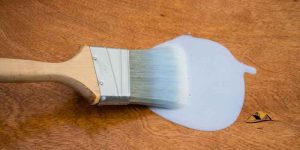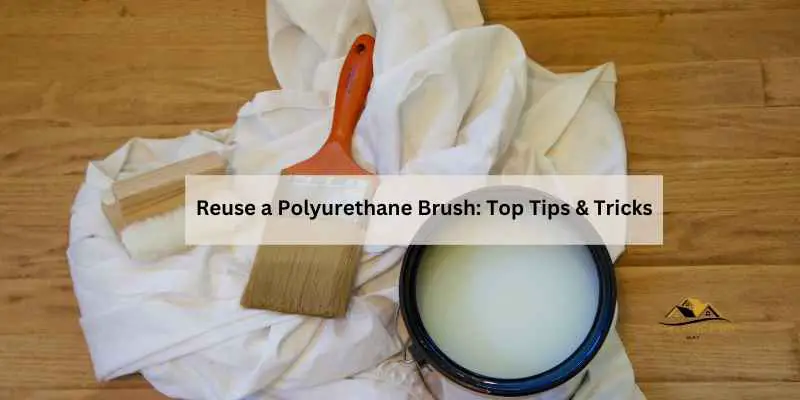To reuse a polyurethane brush, clean it thoroughly with acetone or mineral spirits. Store it in a ziplock bag to keep it from drying out between uses.
If you’re working on a project that requires multiple coats of polyurethane, you may need to reuse the brush between coats. Properly cleaning and storing the brush can save you time and money. Cleaning the brush with acetone or mineral spirits will ensure that it’s ready for reuse without any dried residue.
Storing the brush in a ziplock bag between coats will prevent it from drying out. By following these steps, you can effectively reuse a polyurethane brush and achieve a smooth finish on your project.
Understanding Reusing Polyurethane Brushes
When working on a DIY project that involves applying polyurethane, properly caring for your brushes is essential. Understanding how to reuse polyurethane brushes can save both time and money, ensuring that your brushes maintain their quality for future use. Here, we’ll delve into the best practices for storing brushes between coats and whether it’s possible to reuse a brush after polyurethane application.
How To Store Brushes Between Coats
Properly storing your brushes between coats of polyurethane can help maintain their quality and prevent them from drying out. Here are some effective methods for storing brushes between coats:
- Leave the brush in the can of polyurethane to keep it soaked.
- Wrap the bristles and metal part of the brush in a plastic bag to keep it protected.
- Place the brush in a ziplock bag, ensuring it is not stored in the refrigerator.
Can You Reuse A Brush After Polyurethane?
After applying polyurethane, fully curing the brush can make it challenging to clean. While acetone can effectively remove dried polyurethane, it’s important to consider the material of the brush. Some plastics can be damaged by acetone, so it’s advisable to assess the brush material before attempting to reuse it. If the bristles are plastic, it may be more practical to opt for new brushes to ensure optimal results.
Cleaning And Storing Polyurethane Brushes
Properly cleaning and storing your polyurethane brushes is essential to maintain their longevity and ensure optimal performance. By following the right techniques, you can reuse your brushes multiple times, saving both time and money in the process. In this article, we will explore the best practices for cleaning and storing polyurethane brushes.
H3 heading: Cleaning Hardened Brushes
Cleaning Hardened Brushes
- Soak the hardened brush in acetone for effective cleaning.
- Use a brush comb to remove stubborn residue.
- Rinse the brush with warm, soapy water until clean.
Storing Brushes Overnight
- Leave the brush soaked in a can of polyurethane overnight.
- Wrap the bristles and metal part in a plastic bag for short-term storage.
- Avoid storing the brush in the fridge to prevent damage.
Using Acetone For Cleaning
Acetone is a powerful solvent that effectively cleans dried polyurethane from brushes. However, be cautious when using acetone on plastic brushes, as it may cause damage. If unsure, it’s best to replace the brush to maintain quality.
Effective Brush Cleaning Methods
To effectively clean and reuse a polyurethane brush, start by soaking the brush in mineral spirits or paint thinner to dissolve the polyurethane residue. After soaking, use a brush comb or a wire brush to remove any remaining residue. Finish by washing the brush with warm, soapy water and allowing it to air dry.
This method will help maintain the brush’s quality for future use.
Mineral Spirits And Soap
Soak the polyurethane brush in mineral spirits overnight to dissolve the residue.
Rinse the brush with soapy water the next day to remove any remaining impurities.
Avoiding Bubbling During Application
Ensure the brush is completely dry before using it to prevent bubbling during application.
Choosing The Right Type Of Brush
Select a high-quality brush suitable for polyurethane application to achieve smooth finishes.
Tips For Preserving Brush Quality
When working with polyurethane, it’s crucial to preserve the quality of your brushes to ensure they can be reused effectively. By following a few essential tips, you can maintain the condition of your brushes and extend their lifespan.
Tips For Getting Polyurethane Out Of Brushes
- Use acetone to soften and remove dried polyurethane from brushes.
- Soak the brushes in mineral spirits or soapy water to break down the polyurethane residue.
- Rinse the brushes thoroughly to remove any remaining polyurethane.
Identifying Reusable Brushes
- Inspect the bristles for any hardened polyurethane residue.
- Check the brush handle for any damage or deterioration.
- Ensure the brush retains its original shape and flexibility.
Best Way To Clean Hardened Brushes
If your brushes have hardened polyurethane, follow these steps to clean them:
- Soak the brushes in acetone to soften the hardened polyurethane.
- Gently scrub the bristles to remove the softened residue.
- Rinse the brushes with soapy water to eliminate any remaining polyurethane.

Frequently Asked Questions
Can You Reuse Brush After Polyurethane?
To reuse a brush after polyurethane, clean it with acetone, especially if it’s not plastic. Acetone can damage plastic brushes.
How Do You Store Polyurethane Brushes Overnight?
Store polyurethane brushes overnight by leaving them in a can of poly or wrapping in a plastic bag. Avoid the fridge and use a ziplock bag for short-term storage.
How To Store Varnish Brush Between Coats?
To store a varnish brush between coats, you can either leave it in a can of varnish or wrap it in a plastic bag to keep the bristles moist. For long-term storage, clean the brush with acetone or mineral spirits and store it in its original packaging or a brush holder.
Do not put it in the fridge or let it dry out.
Can You Use Acetone To Clean A Polyurethane Brush?
Yes, acetone can be used to clean a polyurethane brush effectively. However, be cautious as it may damage plastic bristles.
Conclusion
Reusing a polyurethane brush can save you money and time, but it requires proper cleaning and storage. Fully cured polyurethane can be challenging to clean, and using the right material is crucial. Acetone works great for removing dried paint, but it can damage some brush materials.
Proper storage is also important to prevent the brush from drying out between coats. With these tips, you can extend the life of your polyurethane brush and achieve a professional finish on your woodworking projects.


